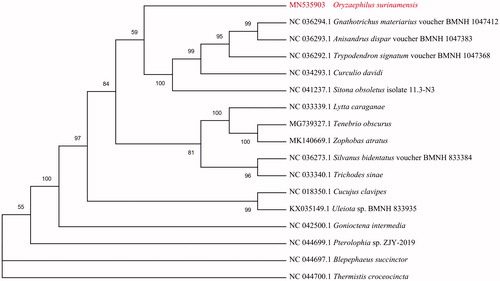Abstract
The saw-toothed grain beetle, Oryzaephilus surinamensis Linné, is a well-known stored-product insect. Beetles were obtained from Xichuan County and the mitochondrial genome was characterized (GenBank accession number MN535903). The mitogenome consists of a circular DNA molecule of 15,941 bp, with only 27.36% GC content. It comprises 13 protein-coding, 22 tRNA, and 2 rDNA genes. The protein-coding genes have typical ATN (Met) initiation codons and are terminated by typical TAN stop codons.
The saw-toothed grain beetle, Oryzaephilus surinamensis Linné, is a stored-product insect found in vegetable foods worldwide (Back and Cotton Citation1926). Although this organism has been known to scientists for more than 240 years (Back and Cotton Citation1926), its mitochondrial genome has not been sequenced completely. Here, we have characterized the complete mitogenome of O. surinamensis to better comprehend its molecular evolution and taxonomic classification.
Samples of adult O. surinamensis (Specimen Accession Number: GYU-20190630-001) were obtained from Jingziguan town (E 111.026°, N 33.244°), Xichuan County, Nanyang City, Henan Province, China, on 30 June 2019. Genomic DNA was isolated and fragmented to build a genomic library of insert Size 400 bp that was sequenced (paired end 2 × 150 bp) using an Illumina HiSeq 4000 (San Diego, CA). We obtained 24,372,898 reads of raw data, 24,012,730 of which were high-quality, clean data (98.52%). The genome was assembled de novo with A5-miseq v20150522 (https://github.com/koadman/docker-A5-miseq) (Coil et al. Citation2014) and SPAdes v3.9.0 (http://cab.spbu.ru/software/spades/) (Bankevich et al. Citation2012).
The mitogenome of O. surinamensis consists of a 15,941 bp circular DNA molecule with 31.68% A, 40.96% T, 9.2% C, and 18.17% G, which is an A/T bias of 72.64%. The AT- and GC-skews of the major strands of the mitogenome were calculated to be approximately −0.12775 and 0.32773, respectively. The A/T-rich region in the mitogenome is 1455 bp, with a 75.26% A + T content, and is located between the srRNA and tRNA-Ile.
The mitogenome of O. surinamensis contains 13 protein-coding genes (PCGs), 22 tRNA genes, and 2 rRNA genes. The order and orientation of the O. surinamensis mitogenome functional areas are identical to those of Tenebrio obscurus, Zophobas atratus, and Blaps rynchopetera mitogenome functional areas (Bai et al. Citation2018; Bai et al. Citation2019; Yang et al. Citation2019). All 13 PCGs have typical ATN (Met) start codons and TAN stop codons. The other genes have alternative start codons: nad1 and atp6 – ATA; nad5, nad3, atp8, nad6, and cox2 – ATT; cox3, nad4, cob, and nad4l – ATG; nad2 and cox1 – ATC. Three genes (nad4l, atp6, and nad6) have a TAA stop codon; three genes (nad1, cob, and nad5) have a TAG stop codon, and seven genes (nad4, nad3, cox3, atp8, cox2, cox1, and nad2) have an incomplete stop codon consisting of a T that is completed by the addition of 3′ A nucleotides to the resultant mRNA. The 22 tRNA genes are interspersed throughout the coding region and range from 58 (tRNA-Ser) to 70 bp (tRNA-Lys). The lrRNA and srRNA genes in the O. surinamensis mitogenome are 1247 and 757 bp long.
To validate the phylogenetic position of O. surinamensis, the mitogenome DNA sequences from 16 species of Cucujiformia were used to construct a phylogenetic tree by the maximum-likelihood method using the MEGA 7 software (Kumar et al. Citation2016) (). Overall, our study provides insight into the mitogenome of O. surinamensis, which will be useful for its taxonomic classification and further phylogenetic reconstruction.
Disclosure statement
The authors report no conflicts of interest. The authors alone are responsible for the content and writing of this article.
Additional information
Funding
References
- Back E, Cotton R. 1926. Biology of the saw-toothed grain beetle Oryzaephilus surinamensis Linne. J agric Res. 33:435–452.
- Bai Y, Li C, Yang M, Liang S. 2018. Complete mitochondrial genome of the dark mealworm Tenebrio obscurus Fabricius (Insecta: Coleoptera: Tenebrionidae). Mitochondrial DNA Part B. 3(1):171–172.
- Bai Y, Wang H, Li G, Luo J, Liang S, Li C. 2019. Complete mitochondrial genome of the super mealworm Zophobas atratus (Fab.) (Insecta: Coleoptera: Tenebrionidae). Mitochondrial DNA Part B. 4(1):1300–1301.
- Bankevich A, Nurk S, Antipov D, Gurevich AA, Dvorkin M, Kulikov AS, Lesin VM, Nikolenko SI, Pham S, Prjibelski A. 2012. SPAdes: a new genome assembly algorithm and its applications to single-cell sequencing. J Comp Biol. 19(5):455–477.
- Coil D, Jospin G, Darling A. 2014. A5-miseq: an updated pipeline to assemble microbial genomes from Illumina MiSeq data. Bioinformatics. 31(4):587–589.
- Kumar S, Stecher G, Tamura K. 2016. MEGA7: molecular evolutionary genetics analysis version 7.0 for bigger datasets. Mol Biol Evol. 33(7):1870–1874.
- Yang Y, Bai Y, Zheng J, Chen J, Ouyang B, Liang S. 2019. Characterization of the complete mitochondrial genome of Blaps rynchopetera Fairmaire (Insecta: Coleoptera: Tenebrionidae) from Dali. Mitochondrial DNA Part B. 4(2):3167–3168.

